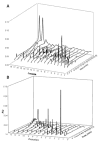Dentin biomodification: strategies, renewable resources and clinical applications
- PMID: 24309436
- PMCID: PMC3972923
- DOI: 10.1016/j.dental.2013.10.012
Dentin biomodification: strategies, renewable resources and clinical applications
Abstract
Objectives: The biomodification of dentin is a biomimetic approach, mediated by bioactive agents, to enhance and reinforce the dentin by locally altering the biochemistry and biomechanical properties. This review provides an overview of key dentin matrix components, targeting effects of biomodification strategies, the chemistry of renewable natural sources, and current research on their potential clinical applications.
Methods: The PubMed database and collected literature were used as a resource for peer-reviewed articles to highlight the topics of dentin hierarchical structure, biomodification agents, and laboratorial investigations of their clinical applications. In addition, new data is presented on laboratorial methods for the standardization of proanthocyanidin-rich preparations as a renewable source of plant-derived biomodification agents.
Results: Biomodification agents can be categorized as physical methods and chemical agents. Synthetic and naturally occurring chemical strategies present distinctive mechanism of interaction with the tissue. Initially thought to be driven only by inter- or intra-molecular collagen induced non-enzymatic cross-linking, multiple interactions with other dentin components are fundamental for the long-term biomechanics and biostability of the tissue. Oligomeric proanthocyanidins show promising bioactivity, and their chemical complexity requires systematic evaluation of the active compounds to produce a fully standardized intervention material from renewable resource, prior to their detailed clinical evaluation.
Significance: Understanding the hierarchical structure of dentin and the targeting effect of the bioactive compounds will establish their use in both dentin-biomaterials interface and caries management.
Keywords: Biomaterials; Carbodiimide; Collagen cross-linking; Dental caries; Dentin; Proanthocyanidins; Resin–dentin interfaces; Surface biomodification.
Copyright © 2013 Academy of Dental Materials. Published by Elsevier Ltd. All rights reserved.
Figures






Similar articles
-
Dual function of proanthocyanidins as both MMP inhibitor and crosslinker in dentin biomodification: A literature review.Dent Mater J. 2018 Mar 30;37(2):173-182. doi: 10.4012/dmj.2017-062. Epub 2017 Nov 23. Dent Mater J. 2018. PMID: 29176304 Review.
-
Efficacy of new natural biomodification agents from Anacardiaceae extracts on dentin collagen cross-linking.Dent Mater. 2017 Oct;33(10):1103-1109. doi: 10.1016/j.dental.2017.07.003. Epub 2017 Jul 24. Dent Mater. 2017. PMID: 28751073
-
Oligomeric proanthocyanidins released from dentin induce regenerative dental pulp cell response.Acta Biomater. 2017 Jun;55:262-270. doi: 10.1016/j.actbio.2017.03.051. Epub 2017 Mar 29. Acta Biomater. 2017. PMID: 28365481 Free PMC article.
-
Dimeric Proanthocyanidins on the Stability of Dentin and Adhesive Biointerfaces.J Dent Res. 2020 Feb;99(2):175-181. doi: 10.1177/0022034519892959. Epub 2019 Dec 11. J Dent Res. 2020. PMID: 31826696 Free PMC article.
-
Effect of carbodiimide on the structural stability of resin/dentin interface.J Conserv Dent. 2016 Nov-Dec;19(6):501-509. doi: 10.4103/0972-0707.194020. J Conserv Dent. 2016. PMID: 27994309 Free PMC article. Review.
Cited by
-
Bis[2-(Methacryloyloxy) Ethyl] Phosphate as a Primer for Enamel and Dentine.J Dent Res. 2021 Sep;100(10):1081-1089. doi: 10.1177/00220345211023477. Epub 2021 Jul 8. J Dent Res. 2021. PMID: 34238050 Free PMC article.
-
Does the pH of the grape seed extract interfere in the biomodification capacity of dentin collagen?Braz Dent J. 2024 Dec 16;35:e246048. doi: 10.1590/0103-6440202406048. eCollection 2024. Braz Dent J. 2024. PMID: 39699496 Free PMC article.
-
Experimental primers containing synthetic and natural compounds reduce enzymatic activity at the dentin-adhesive interface under cyclic loading.Dent Mater. 2016 Oct;32(10):1248-1255. doi: 10.1016/j.dental.2016.07.012. Epub 2016 Aug 11. Dent Mater. 2016. PMID: 27524231 Free PMC article.
-
Proanthocyanidin encapsulation for sustained bioactivity in dentin bioadhesion: A two-year study.Dent Mater. 2022 Feb;38(2):421-430. doi: 10.1016/j.dental.2021.12.024. Epub 2022 Jan 5. Dent Mater. 2022. PMID: 34998601 Free PMC article.
-
Effect of dentin biomodifiers on the immediate and long-term bond strengths of a simplified etch and rinse adhesive to dentin.Restor Dent Endod. 2017 Aug;42(3):188-199. doi: 10.5395/rde.2017.42.3.188. Epub 2017 Jul 12. Restor Dent Endod. 2017. PMID: 28808635 Free PMC article.
References
-
- Marshall GW., Jr Dentin: microstructure and characterization. Quintessence Int. 1993;24:606–17. - PubMed
-
- Marshall GW, Jr, Marshall SJ, Kinney JH, Balooch M. The dentin substrate: structure and properties related to bonding. J Dent. 1997;25:441–58. - PubMed
-
- Gelse K, Poschl E, Aigner T. Collagens--structure, function, and biosynthesis. Adv Drug Deliv Rev. 2003;55:1531–46. - PubMed
-
- Ortiz C, Boyce MC. Materials science. Bioinspired structural materials. Science. 2008;319:1053–4. - PubMed
-
- Silver FH, Horvath I, Foran DJ. Viscoelasticity of the vessel wall: the role of collagen and elastic fibers. Crit Rev Biomed Eng. 2001;29:279–301. - PubMed
Publication types
MeSH terms
Substances
Grants and funding
LinkOut - more resources
Full Text Sources
Other Literature Sources

